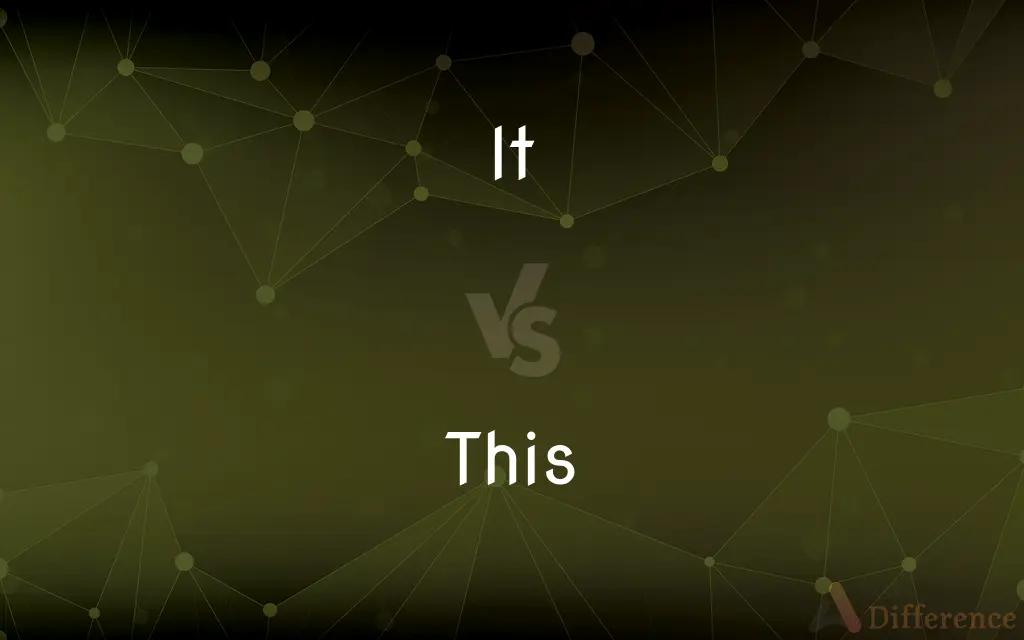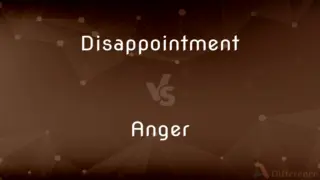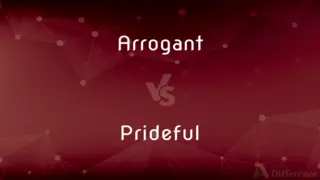It vs. This — What's the Difference?
Edited by Tayyaba Rehman — By Urooj Arif — Updated on March 20, 2024
"It" is a pronoun for referencing a previously mentioned or understood object, while "this" points to a specific item or idea, often closer in context or physically.

Difference Between It and This
Table of Contents
ADVERTISEMENT
Key Differences
"It" is a third-person singular pronoun used to refer to a previously mentioned or easily identified object, animal, or concept. It is often used when the gender of the object or subject isn't known or isn't relevant. For example, in the sentence "The book is on the table; it is red," "it" refers back to "the book," which has already been introduced. On the other hand, "this" is a demonstrative pronoun used to identify a specific object, situation, or concept that is close in terms of distance or context. It is used to point out something that is either physically near the speaker or has just been mentioned in the conversation. For example, "This is my book" typically indicates that the book is physically close to the speaker or is the current topic of discussion.
"It" can also be used as a subject in sentences that describe the weather, time, distances, and general situations, like in "It is raining" or "It is two o'clock." In these cases, "it" does not refer back to a specific noun but serves as a placeholder subject in the sentence structure. Conversely, "this" is often used to introduce something or to draw attention to a specific item or detail, such as in "This painting is beautiful" when pointing out a painting during a gallery visit.
The use of "it" can be somewhat abstract, referring to ideas or situations, as in "It is important to note that...," where "it" doesn't refer to a specific, tangible item but rather to the concept being discussed. "This," however, is more concrete and immediate, bringing the listener's or reader's attention to a particular entity or idea, often accompanied by a gesture or a direct look when in person, as in "Look at this!"
While both "it" and "this" serve to refer to or replace nouns, "this" carries an additional layer of immediacy or specificity, whether in terms of physical proximity, temporal closeness, or importance in the discourse. Understanding the nuances between "it" and "this" enhances clarity in communication, ensuring that references are made accurately and understood as intended.
Comparison Chart
Function
Pronoun for a non-specific, previously mentioned or understood object.
Demonstrative pronoun for identifying something specific and close.
ADVERTISEMENT
Usage
Refers back to a mentioned object, or used in general statements.
Points to something specific, often accompanied by a gesture.
Context
More general and abstract.
More specific and immediate.
Examples
"It is sunny." "I found a pen; it was under the table."
"This book is mine." "Look at this!"
Proximity
Not necessarily close in physical or contextual terms.
Implies closeness, either physically or in terms of conversation focus.
Compare with Definitions
It
A pronoun used to refer to a previously mentioned or understood entity, often without specifying gender.
I have a cat. It is very playful.
This
A demonstrative pronoun used to indicate a specific item or concept, especially one that is close physically or contextually.
This is my favorite song.
It
Common in describing general situations or conditions, such as weather or time.
It is cold outside.
This
Introduces or highlights something in the immediate environment or conversation.
This looks difficult.
It
Can refer to animals, objects, or abstract concepts.
It is a well-known fact that...
This
Suggests closeness or direct relevance to the current situation.
Who owns this?
It
Refers to something already known in the discourse.
Did you see the movie? It was great!
This
Can emphasize the importance or relevance of a particular point or item.
This is what I mean.
It
Often used in impersonal constructions.
It seems that we are lost.
This
Often used to introduce new information or objects.
This is James, my coworker.
It
An animal that has been neutered
The cat is an it.
This
Being just mentioned or present in space, time, or thought
She left early this morning.
It
The third-person singular personal pronoun used to refer to an inanimate object, abstract entity, or non-human living thing.
Take this book and put it on the shelf.
Take each day as it comes.
I found a poor little cat. It seems to be half starving.
This
Being nearer or more immediate
This side and that side.
It
A third-person singular personal pronoun used to refer to a baby or child, especially of unknown gender.
She took the baby and held it in her arms.
This
Being about to be stated or described
Just wait till you hear this story.
It
(obsolete) An affectionate third-person singular personal pronoun.
This
(Informal) Used as a substitute for the indefinite article
Looking for this book of recipes.
It
A third-person singular personal pronoun used to refer to an animate referent who is transgender or is neither female nor male.
This
To this extent; so
Never stayed out this late.
It
Used to refer to someone being identified, often on the phone, but not limited to this situation.
It's me. John.
Is it her?
It is I, your king.
This
The (thing) here used in indicating something or someone nearby.
This classroom is where I learned to read and write.
It
The impersonal pronoun, used without referent as the subject of an impersonal verb or statement (known as the dummy pronoun, dummy it or weather it).
It is nearly 10 o’clock.
It’s 10:45.
It’s very cold today.
It’s lonely without you.
This
The known (thing) used in indicating something or someone just mentioned.
They give the appearance of knowing what they're doing. It's this appearance that lets them get away with so much.
It
The impersonal pronoun, used without referent, or with unstated but contextually implied referent, in various short idioms or expressions.
Rough it
Live it up
Stick it out
This
The known (thing) used in indicating something or someone about to be mentioned.
When asked what he wanted for his birthday, he gave this reply: “[…]”
It
Referring to a desirable quality or ability, or quality of being successful, fashionable or in vogue.
After all these years, she still has it.
This
(informal) A known (thing) used in first mentioning a person or thing that the speaker does not think is known to the audience. Compare with "a certain ...".
I met this woman the other day who's allergic to wheat. I didn't even know that was possible!
There's just this nervous mannerism that Bob has with his hands, and it drives me crazy.
It
The impersonal pronoun, used as a placeholder for a delayed subject, or less commonly, object; known as the dummy pronoun (according to some definitions), anticipatory it or, more formally in linguistics, a syntactic expletive. The delayed subject is commonly a to-infinitive, a gerund, or a noun clause introduced by a subordinating conjunction.
This
(of a time reference) Designates the current or next instance.
It's cold this morning.
I plan to go to London this Friday.
It
All or the end; something after which there is no more.
Are there more students in this class, or is this it?
That's it—I'm not going to any more candy stores with you.
This
To the degree or extent indicated.
I need this much water.
Do we need this many recommendations?
We've already come this far, we can't turn back now.
It
(obsolete) Followed by an omitted and understood relative pronoun: That which; what.
This
The thing, item, etc. being indicated.
This isn't the item that I ordered.
It
(obsolete) Its.
This
(philosophy) Something being indicated that is here; one of these.
It
One who is neither a he nor a she; a creature; a dehumanized being.
This
(Internet slang) Indicates the speaker's strong approval or agreement with the previous material.
― I wish trolls could be banned from the forum immediately, without any discussion.
― This!
― This!
It
The person who chases and tries to catch the other players in the playground game of tag.
In the next game, Adam and Tom will be it…
This
As a demonstrative pronoun, this denotes something that is present or near in place or time, or something just mentioned, or that is just about to be mentioned.
When they heard this, they were pricked in their heart.
But know this, that if the good man of the house had known in what watch the thief would come, he would have watched.
It
The game of tag.
Let's play it at breaktime.
This
As an adjective, this has the same demonstrative force as the pronoun, but is followed by a noun; as, this book; this way to town.
This way and that wavering sails they bend.
A body of this or that denomination is produced.
Their judgment in this we may not, and in that we need not, follow.
Consider the arguments which the author had to write this, or to design the other, before you arraign him.
Thy crimes . . . soon by this or this will end.
This twenty years have I been with thee..
I have not wept this years; but nowMy mother comes afresh into my eyes.
It
Georg Groddeck}}
It
(colloquial) Most fashionable, popular, or in vogue.
It
The neuter pronoun of the third person, corresponding to the masculine pronoun he and the feminine she, and having the same plural (they, their or theirs, them).
The day present hath ever inough to do with it owne grief.
Do, child, go to it grandam, child.
It knighthood shall do worse. It shall fright all it friends with borrowing letters.
The fruit tree yielding fruit after his (its) kind.
It
As a substance for any noun of the neuter gender; as, here is the book, take it home.
It
As a demonstrative, especially at the beginning of a sentence, pointing to that which is about to be stated, named, or mentioned, or referring to that which apparent or well known; as, I saw it was John.
It is I; be not afraid.
Peter heard that it was the Lord.
It
As an indefinite nominative for a impersonal verb; as, it snows; it rains.
It
As a substitute for such general terms as, the state of affairs, the condition of things, and the like; as, how is it with the sick man?
Think on me when it shall be well with thee.
It
As an indefinite object after some intransitive verbs, or after a substantive used humorously as a verb; as, to foot it (i. e., to walk).
The Lacedemonians, at the Straits of Thermopylæ, when their arms failed them, fought it out with nails and teeth.
Whether the charmer sinner it, or saint it,If folly grows romantic, I must paint it.
Common Curiosities
How does "this" add emphasis in a sentence?
"This" can draw attention to a specific item or detail, emphasizing its importance or relevance in the current context.
Is "it" used only for inanimate objects?
"It" can refer to animals, inanimate objects, or abstract ideas, especially when the gender is unknown or irrelevant.
Why is "it" used in expressions about weather, time, and distance?
In such expressions, "it" serves as an impersonal subject, not referring to a specific object but used to construct the sentence.
Can "this" be used to refer to something far away?
"This" typically indicates something close in distance or context. For distant objects, "that" is more appropriate.
Can "it" and "this" be used interchangeably?
While they can sometimes refer to the same object or concept, their usage depends on the context and specificity required. "It" is more general, while "this" is more specific and immediate.
Can "this" be used to refer to abstract concepts?
Yes, "this" can refer to abstract ideas, especially when they are being introduced or are central to the current discussion, like "This concept of freedom is complex."
Can "it" refer to people in any context?
Generally, "it" is not used to refer to people, except in certain expressions like "it's me" or when referring to a baby whose gender is unknown or unspecified.
When should I use "it" instead of "this"?
Use "it" to refer back to a previously mentioned object or for general statements, especially when the object's identity is clear or has been established.
What is the role of "it" in idiomatic expressions?
"It" is frequently used in idioms where it doesn't refer to a specific noun but is part of a fixed expression, like "it's raining cats and dogs."
In what situations might "it" and "this" cause confusion?
Confusion can arise if "it" and "this" are used vaguely without a clear antecedent, making it difficult for the reader or listener to understand the reference.
How does physical gesture play a role with "this"?
In face-to-face communication, "this" is often accompanied by a gesture, such as pointing, to indicate the specific object or area being referred to.
How do "it" and "this" contribute to coherence in a text?
"It" and "this" help maintain coherence by linking sentences and ideas, referring back to previously mentioned concepts or introducing new ones clearly.
How does the use of "this" affect the tone of a sentence?
Using "this" can make a sentence sound more immediate and engaged, drawing the listener's or reader's attention to a specific point or object.
How does "it" function in passive voice sentences?
"It" is often used as a placeholder subject in passive constructions, such as "It was said that the event would be postponed."
Is "this" used differently in written and spoken English?
In written English, "this" can refer to the subject being discussed, while in spoken English, it's often accompanied by physical gestures to specify the reference.
Share Your Discovery

Previous Comparison
Disappointment vs. Anger
Next Comparison
Arrogant vs. PridefulAuthor Spotlight
Written by
Urooj ArifUrooj is a skilled content writer at Ask Difference, known for her exceptional ability to simplify complex topics into engaging and informative content. With a passion for research and a flair for clear, concise writing, she consistently delivers articles that resonate with our diverse audience.
Edited by
Tayyaba RehmanTayyaba Rehman is a distinguished writer, currently serving as a primary contributor to askdifference.com. As a researcher in semantics and etymology, Tayyaba's passion for the complexity of languages and their distinctions has found a perfect home on the platform. Tayyaba delves into the intricacies of language, distinguishing between commonly confused words and phrases, thereby providing clarity for readers worldwide.















































